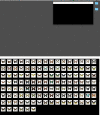Perceptual holistic color combination analysis of Papilionidae butterflies as aesthetic objects
- PMID: 33112869
- PMCID: PMC7592781
- DOI: 10.1371/journal.pone.0240356
Perceptual holistic color combination analysis of Papilionidae butterflies as aesthetic objects
Abstract
In this study, we clarified the holistic color combination rules of human-preferred Papilionidae butterflies by examining the hue, lightness, and chroma. A set of 118 Papilionidae butterfly images used in our previous study was analyzed. These images were classified via hierarchical density-based spatial clustering based on perceptual similarities of colors that were obtained from a subjective image classification experiment. The color combinations of the clustered images were determined based on representative colors that were analyzed by a Gaussian mixture model with minimum message length and the color combination types defined in our previous study. Consequently, we obtained the following holistic color combination rules for Papilionidae: 1) contrasting lightness, similar chroma, and similar hue, 2) contrasting lightness, contrasting chroma, and similar hue, 3) similar lightness, similar chroma, and complementary hue, and 4) similar lightness, similar chroma, and similar hue. These rules suggest that minority color harmony theories are valid under particular conditions.
Conflict of interest statement
The authors have declared that no competing interests exist.
Figures








References
-
- Ou L, Chong P, Luo MR, Minchew C. Additivity of colour harmony. Color Res. Appl. 2011;36(5):355–372.
-
- Ou L, Luo MR. A colour harmony model for two-colour combinations. Color Res. Appl. 2006;31(3):191–204.
-
- Ou L, Yuan Y, Sato T, et al. Universal models of colour emotion and colour harmony. Color Res. Appl. 2018;43(5):736–748.
-
- Szabó F, Bodrogi P, Schanda J. Experimental modeling of colour harmony. Color Res. Appl. 2010;35(1):34–49.
-
- Kobayasi M. Analysis of color combination in fine art paintings. Proc. Int. Symp. Multispectral Imaging Color Reproduction. 1999;139–142.
MeSH terms
LinkOut - more resources
Full Text Sources

